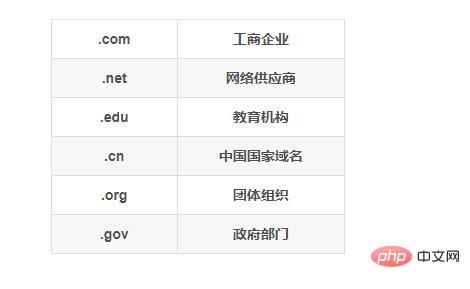 Operation and Maintenance
Operation and Maintenance
 Linux Operation and Maintenance
Linux Operation and Maintenance
 Which is the linux dns configuration file?
Which is the linux dns configuration file?
Which is the linux dns configuration file?
The linux dns configuration file is "/etc/resolv.conf". This configuration file is used to configure the DNS client. It contains the domain name search order of the host and the address of the DNS/server. Each line includes a keyword and one or more spaces separated parameters.

#The operating environment of this tutorial: linux5.9.8 system, Dell G3 computer.
Which is the linux dns configuration file?
In Linux, the configuration file of the DNS server is "/etc/resolv.conf".
/etc/resolv.conf file is used to configure the DNS client. It contains the domain name search order of the host and the address of the DNS/server. Each line includes a keyword and one or more space-separated parameters. .
Basic introduction to DNS:
1. Introduction to DNS
DNS (Domain Name System) means domain name resolution server. It is an application layer protocol. A service of the Internet. As a distributed database that maps domain names and IP addresses to each other, it can make people access the Internet more conveniently. The DNS service uses port 53 of TCP and UDP. TCP port 53 is used to connect to the DNS server, and UDP port 53 is used to resolve DNS. The length limit for each level of domain name is 63 characters, and the total length of the domain name cannot exceed 253 characters.
2. The role of DNS
Forward analysis: Find the corresponding IP address based on the domain name
Reverse analysis: Check the corresponding domain name based on the IP address
3. DNS domain name structure

1) The root domain
is located at the top level of the tree structure, and is represented by "."
2) Top-level domain
generally represents a type of organization or country region

3) Second-level domain
is used to indicate A specific organization within the top-level domain. The second-level domain names under the national top-level domain are uniformly managed by national departments. For example: .net.cn
. .edu.cn
. com.cn
4) Sub-domain/third-level domain
The domains at all levels created under the second-level domain are collectively called sub-domains. Each organization or user can freely apply to register their own domain name
5) Host
The host is located at the bottom of the domain name space and is a specific computer
Host name: www
# There is a many-to-one relationship between domain names and IP addresses. An IP address does not necessarily correspond to only one domain name, and a domain name can only correspond to one IP address
4. DNS server type
1 ) The main domain name server
is responsible for maintaining all domain name information in a region. It is the authoritative information source for all specific information, and the data can be modified. When building a primary domain name server, you need to create the address data file for the area you are responsible for.
2) Secondary domain name server
When the primary domain name server fails, shuts down, or is overloaded, the secondary domain name server provides domain name resolution services as a backup service. The resolution results provided from the domain name server are not determined by yourself, but come from the main domain name server. When building a secondary domain name server, you need to specify the location of the primary domain name server so that the server can automatically synchronize the region's address database.
3) Cache domain name server
Only provides the caching function of domain name resolution results. The purpose is to improve query speed and efficiency, but there is no domain name database. It fetches the result of each domain name server query from a remote server and caches it to respond to subsequent queries for the same information. Caching name servers are not authoritative servers because all information provided is indirect. When building a cache domain name server, you must set the root domain or specify other DNS servers as the resolution source.
4) Forwarding domain name server
is responsible for local queries of all non-local domain names. After the forwarding domain name server receives the query request, it searches it in its cache. If it cannot find it, it forwards the request to the specified domain name server in sequence until the result is found, otherwise it returns a result that cannot be mapped.
Related recommendations: "
Linux Video Tutorial"
The above is the detailed content of Which is the linux dns configuration file?. For more information, please follow other related articles on the PHP Chinese website!

Hot AI Tools

Undresser.AI Undress
AI-powered app for creating realistic nude photos

AI Clothes Remover
Online AI tool for removing clothes from photos.

Undress AI Tool
Undress images for free

Clothoff.io
AI clothes remover

Video Face Swap
Swap faces in any video effortlessly with our completely free AI face swap tool!

Hot Article

Hot Tools

Notepad++7.3.1
Easy-to-use and free code editor

SublimeText3 Chinese version
Chinese version, very easy to use

Zend Studio 13.0.1
Powerful PHP integrated development environment

Dreamweaver CS6
Visual web development tools

SublimeText3 Mac version
God-level code editing software (SublimeText3)

Hot Topics
 1386
1386
 52
52
 How to use docker desktop
Apr 15, 2025 am 11:45 AM
How to use docker desktop
Apr 15, 2025 am 11:45 AM
How to use Docker Desktop? Docker Desktop is a tool for running Docker containers on local machines. The steps to use include: 1. Install Docker Desktop; 2. Start Docker Desktop; 3. Create Docker image (using Dockerfile); 4. Build Docker image (using docker build); 5. Run Docker container (using docker run).
 Difference between centos and ubuntu
Apr 14, 2025 pm 09:09 PM
Difference between centos and ubuntu
Apr 14, 2025 pm 09:09 PM
The key differences between CentOS and Ubuntu are: origin (CentOS originates from Red Hat, for enterprises; Ubuntu originates from Debian, for individuals), package management (CentOS uses yum, focusing on stability; Ubuntu uses apt, for high update frequency), support cycle (CentOS provides 10 years of support, Ubuntu provides 5 years of LTS support), community support (CentOS focuses on stability, Ubuntu provides a wide range of tutorials and documents), uses (CentOS is biased towards servers, Ubuntu is suitable for servers and desktops), other differences include installation simplicity (CentOS is thin)
 What to do if the docker image fails
Apr 15, 2025 am 11:21 AM
What to do if the docker image fails
Apr 15, 2025 am 11:21 AM
Troubleshooting steps for failed Docker image build: Check Dockerfile syntax and dependency version. Check if the build context contains the required source code and dependencies. View the build log for error details. Use the --target option to build a hierarchical phase to identify failure points. Make sure to use the latest version of Docker engine. Build the image with --t [image-name]:debug mode to debug the problem. Check disk space and make sure it is sufficient. Disable SELinux to prevent interference with the build process. Ask community platforms for help, provide Dockerfiles and build log descriptions for more specific suggestions.
 How to view the docker process
Apr 15, 2025 am 11:48 AM
How to view the docker process
Apr 15, 2025 am 11:48 AM
Docker process viewing method: 1. Docker CLI command: docker ps; 2. Systemd CLI command: systemctl status docker; 3. Docker Compose CLI command: docker-compose ps; 4. Process Explorer (Windows); 5. /proc directory (Linux).
 What computer configuration is required for vscode
Apr 15, 2025 pm 09:48 PM
What computer configuration is required for vscode
Apr 15, 2025 pm 09:48 PM
VS Code system requirements: Operating system: Windows 10 and above, macOS 10.12 and above, Linux distribution processor: minimum 1.6 GHz, recommended 2.0 GHz and above memory: minimum 512 MB, recommended 4 GB and above storage space: minimum 250 MB, recommended 1 GB and above other requirements: stable network connection, Xorg/Wayland (Linux)
 Detailed explanation of docker principle
Apr 14, 2025 pm 11:57 PM
Detailed explanation of docker principle
Apr 14, 2025 pm 11:57 PM
Docker uses Linux kernel features to provide an efficient and isolated application running environment. Its working principle is as follows: 1. The mirror is used as a read-only template, which contains everything you need to run the application; 2. The Union File System (UnionFS) stacks multiple file systems, only storing the differences, saving space and speeding up; 3. The daemon manages the mirrors and containers, and the client uses them for interaction; 4. Namespaces and cgroups implement container isolation and resource limitations; 5. Multiple network modes support container interconnection. Only by understanding these core concepts can you better utilize Docker.
 What is vscode What is vscode for?
Apr 15, 2025 pm 06:45 PM
What is vscode What is vscode for?
Apr 15, 2025 pm 06:45 PM
VS Code is the full name Visual Studio Code, which is a free and open source cross-platform code editor and development environment developed by Microsoft. It supports a wide range of programming languages and provides syntax highlighting, code automatic completion, code snippets and smart prompts to improve development efficiency. Through a rich extension ecosystem, users can add extensions to specific needs and languages, such as debuggers, code formatting tools, and Git integrations. VS Code also includes an intuitive debugger that helps quickly find and resolve bugs in your code.
 vscode cannot install extension
Apr 15, 2025 pm 07:18 PM
vscode cannot install extension
Apr 15, 2025 pm 07:18 PM
The reasons for the installation of VS Code extensions may be: network instability, insufficient permissions, system compatibility issues, VS Code version is too old, antivirus software or firewall interference. By checking network connections, permissions, log files, updating VS Code, disabling security software, and restarting VS Code or computers, you can gradually troubleshoot and resolve issues.



